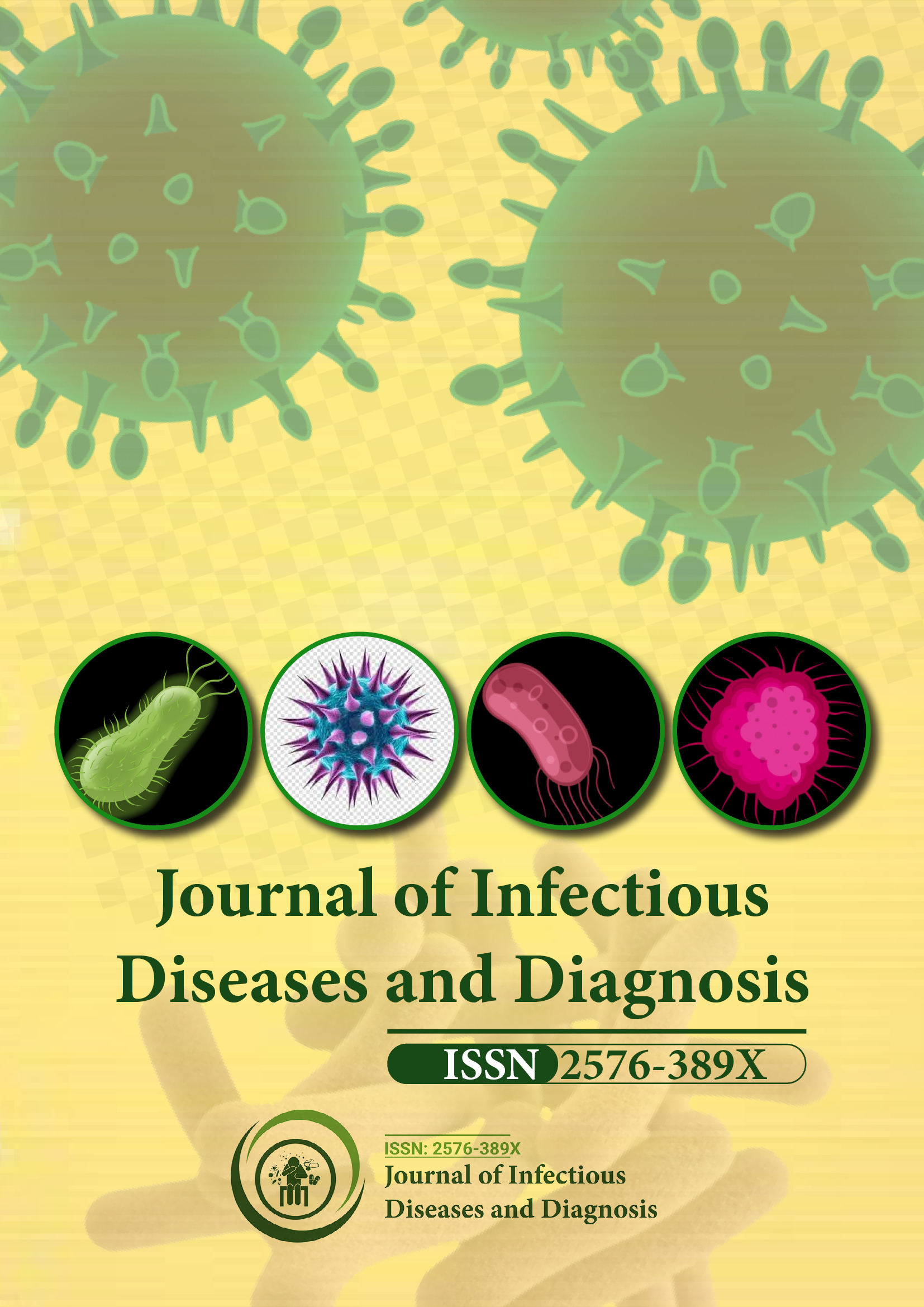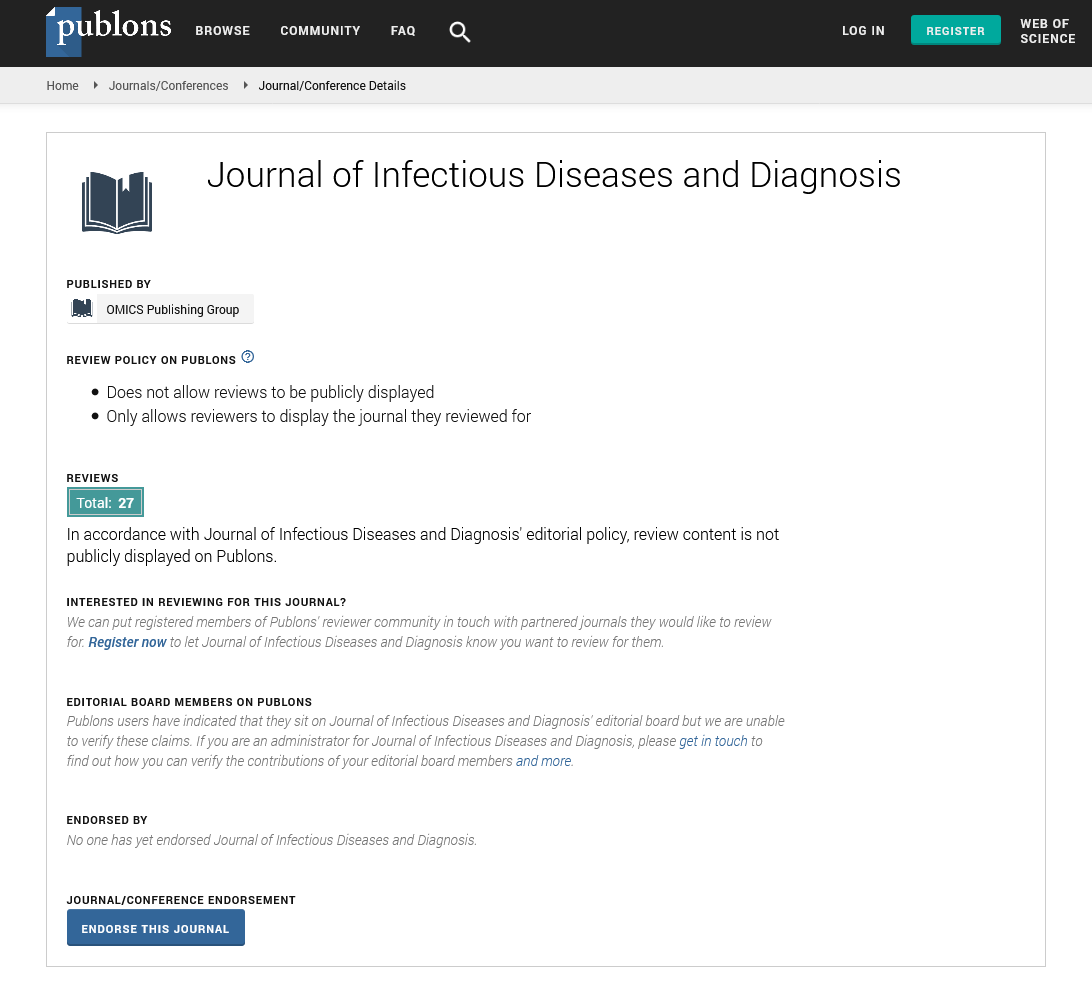Indexed In
- RefSeek
- Hamdard University
- EBSCO A-Z
- Publons
- Euro Pub
- Google Scholar
Useful Links
Share This Page
Journal Flyer

Open Access Journals
- Agri and Aquaculture
- Biochemistry
- Bioinformatics & Systems Biology
- Business & Management
- Chemistry
- Clinical Sciences
- Engineering
- Food & Nutrition
- General Science
- Genetics & Molecular Biology
- Immunology & Microbiology
- Medical Sciences
- Neuroscience & Psychology
- Nursing & Health Care
- Pharmaceutical Sciences
Perspective - (2025) Volume 10, Issue 4
Infectious Diseases in Children: Patterns, Prevention and Public Health Perspectives
Samuel Nelson*Received: 30-Jun-2025, Manuscript No. JIDD-25-29509; Editor assigned: 03-Jul-2025, Pre QC No. JIDD-25-29509 (PQ); Reviewed: 17-Jul-2025, QC No. JIDD-25-29509; Revised: 24-Jul-2025, Manuscript No. JIDD-25-29509 (R); Published: 31-Jul-2025, DOI: 10.35248/2576-389X.25.10.342
Description
Infectious diseases remain one of the most common health challenges among children worldwide. Their impact ranges from mild and self-limiting illnesses to severe conditions that may require intensive medical care. Children are particularly vulnerable because their immune systems are still in the process of development and their close interactions in households, schools and communities increase the chance of exposure. The study and management of infectious diseases in children are essential for improving survival, reducing morbidity and ensuring healthy development.
Common infectious diseases in children
Respiratory tract infections are among the most frequent illnesses in children. Conditions such as pneumonia, bronchiolitis, influenza and the common cold affect millions each year. While many respiratory infections are viral and resolve with supportive care, bacterial causes such as Streptococcus pneumoniae or Haemophilus influenzae can lead to severe pneumonia, demanding antibiotic treatment and sometimes hospitalization.
Gastrointestinal infections represent another leading cause of disease burden. Pathogens like rotavirus, norovirus and enteric bacteria such as Escherichia coli or Salmonella cause diarrhea and vomiting. These infections may result in dehydration, which can be life-threatening if not managed promptly. Oral rehydration therapy has been an effective tool in managing such cases and vaccines such as rotavirus vaccine have significantly reduced incidence in many regions.
Vector-borne diseases also affect children, especially in tropical and subtropical regions. Malaria, transmitted by the Anopheles mosquito, remains a major public health concern. Children under five are the most affected, with high mortality rates if treatment is delayed. Dengue, chikungunya and Zika virus infections add to this burden, presenting with fever, rash and in some cases, severe complications.
Vaccine-preventable diseases have historically caused widespread child mortality but have been greatly reduced through immunization programs. Diseases such as measles, mumps, rubella, diphtheria and pertussis once posed significant threats but are now largely controlled where vaccination coverage is high. However, vaccine hesitancy and gaps in healthcare infrastructure can lead to outbreaks, highlighting the ongoing need for widespread immunization efforts.
Transmission and risk factors
Infectious diseases spread through multiple routes in children. Airborne transmission is common in respiratory illnesses, while fecal-oral transmission often accounts for gastrointestinal diseases. Vector-borne and contact-based spread also play major roles in certain infections. Close physical contact among children, inadequate sanitation, malnutrition and limited access to healthcare services further increase vulnerability.
Malnutrition is an important factor that weakens the immune system, making children more susceptible to infections and prolonging recovery times. Similarly, poor hygiene practices, overcrowding in households or schools and lack of safe drinking water are significant contributors to disease spread.
Diagnosis and management
Timely diagnosis is important for effective management of infectious diseases in children. Clinical examination remains a first step, but laboratory testing, including cultures, antigen detection and molecular diagnostics, provide confirmation of pathogens. Advancements in point-of-care tests have improved early detection, especially for diseases like malaria, influenza and COVID-19.
Treatment depends on the type of infection. Viral infections often require supportive care, including hydration, fever management and rest. Antiviral agents are available for certain diseases, such as influenza and HIV, but their use is more limited compared to antibiotics for bacterial infections. Bacterial diseases often respond to antibiotics, but antimicrobial resistance is an emerging threat that complicates therapy. Judicious use of antibiotics is therefore essential to preserve their effectiveness.
Preventive measures are equally important in reducing the disease burden. Vaccination remains one of the most effective strategies, protecting children against multiple severe illnesses. Improved sanitation, safe drinking water, nutrition programs and health education further contribute to prevention.
Impact on child health and society
Infectious diseases in children not only affect immediate health but also have long-term consequences. Repeated infections can impair growth, cognitive development and school attendance, leading to broader social and economic impacts. Hospitalization and medical costs impose financial strain on families, especially in low-resource settings. In addition, outbreaks disrupt communities, overwhelming healthcare systems and creating challenges in controlling disease spread.
Global initiatives have made progress in reducing infectious disease burden in children, yet disparities persist. Regions with limited healthcare access continue to record high child mortality due to preventable and treatable conditions. Efforts to expand vaccination programs, strengthen healthcare infrastructure and provide education on hygiene and nutrition remain central to global child health agendas.
Emerging challenges
New infectious threats continue to appear. The COVID-19 pandemic demonstrated how rapidly respiratory pathogens can spread globally, with children affected both directly through illness and indirectly through disruptions to healthcare and education systems. Antimicrobial resistance is another major concern; as resistant strains of bacteria threaten to reduce the effectiveness of existing treatments. Climate change also contributes by altering patterns of vector-borne diseases, expanding the regions where malaria or dengue may spread.
Another challenge lies in ensuring equitable access to healthcare technologies. While some regions benefit from advanced diagnostics, treatments and vaccines, others face shortages and logistical barriers. Bridging this gap is essential for global child health security.
Conclusion
Infectious diseases in children remain a major focus of global health due to their widespread occurrence and impact. They range from respiratory and gastrointestinal infections to vectorborne and vaccine-preventable diseases, each posing unique challenges in diagnosis, treatment and prevention. Addressing these diseases requires a combination of medical care, preventive strategies and public health interventions. Continued investment in research, vaccination, sanitation and health education will help reduce the burden of childhood infections and improve overall survival and quality of life.
Citation: Nelson S (2025). Infectious Diseases in Children: Patterns, Prevention and Public Health Perspectives. J Infect Dis Diagn. 10:342.
Copyright: © 2025 Nelson S. This is an open-access article distributed under the terms of the Creative Commons Attribution License, which permits unrestricted use, distribution and reproduction in any medium, provided the original author and source are credited.

